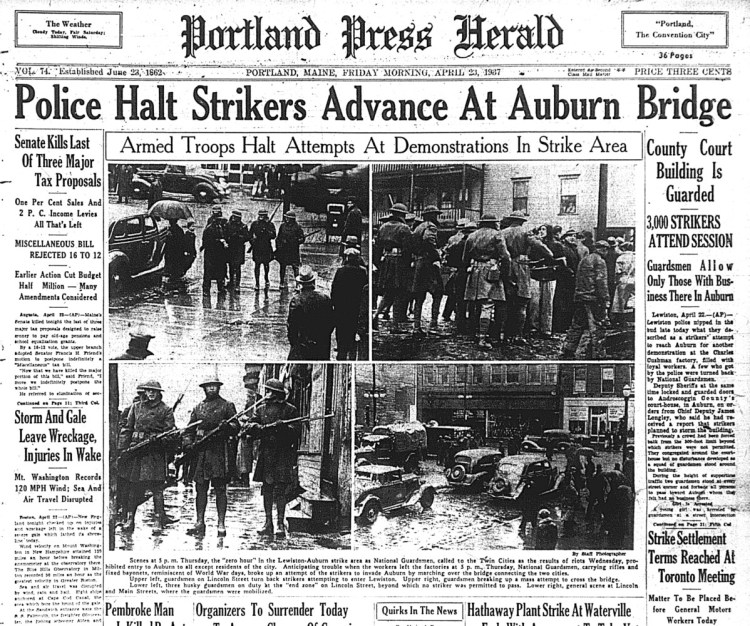March 25, 1937: Workers at shoe manufacturers in Lewiston and Auburn initiate a strike that grows to more than 4,000 workers by early April. The strike draws widespread attention but ends three months later in failure.
 In Maine, where many shoe manufacturers had set up shop to flee the unions’ organizing power in Massachusetts, shoemaking was concentrated largely in Lewiston and Auburn. Nineteen factories in the adjoining cities employed nearly 6,000 workers.
In Maine, where many shoe manufacturers had set up shop to flee the unions’ organizing power in Massachusetts, shoemaking was concentrated largely in Lewiston and Auburn. Nineteen factories in the adjoining cities employed nearly 6,000 workers.
Having conducted a failed strike in 1932, the cities’ shoe workers sought help in 1937 from the Congress of Industrial Organizations, which today forms part of the AFL-CIO. CIO representatives promptly told them they were making less money than laborers with equivalent jobs in Massachusetts.

Labor organizer Powers Hapgood photographed in Lewiston, probably on April 22, 1937. Portland Press Herald photo courtesy Portland Public Library Special Collections and Archives
CIO organizer Powers Hapgood (1899-1949), a Harvard graduate, arrived on March 12 to coordinate the strike. A week later, the union petitioned the shoe manufacturers’ association for recognition. They didn’t respond, prompting the strike.
“For more than three months, thousands of shoe workers, many of them women and most of French-Canadian descent, battled manufacturers, courts, police, the press and the Catholic Church in their quest for union recognition,” Robert Bussell writes in his biography of Hapgood.
The workers demand higher pay, a shorter workweek, better employment conditions and union representation. By early April, 4,000 to 5,000 workers are absent from their jobs.
Hoisting Hapgood on their shoulders, about 1,000 marching strikers defy a court injunction on April 21 by staging a march across a bridge linking the two cities. When a fight erupts between them and the police, Gov. Lewis Barrows calls in the Maine Army National Guard. On May 6, a judge finds Hapgood and seven other strike leaders in contempt of the injunction and sentences them to six-month prison terms.
Losing money and worker support and faced with unyielding opposition from the manufacturers, Hapgood and the union leadership call an end to the strike on June 28. The Maine Supreme Judicial Court overturns the union organizers’ contempt convictions, and they are released.
One significant thing had changed during the 1937 strike, according to cultural historian Mark Paul Richard.
“What distinguishes this strike from the others in the 1930s, something that other accounts have not emphasized,” he writes in a 2008 book on French-Canadian culture in the United States, “is that some Franco-Americans became openly critical of their clergy.” In the early stage of the strike, the strikers ignore parish priests who urge them to go back to work.
As for Hapgood, he acknowledges the union’s mistakes in Maine and learns from them, going on to become a key figure in the CIO hierarchy, coordinating its national efforts to organize workers.
Joseph Owen is a retired copy desk chief of the Morning Sentinel and Kennebec Journal and board member of the Kennebec Historical Society. He can be contacted at: jowen@mainetoday.com.
Send questions/comments to the editors.



Comments are no longer available on this story